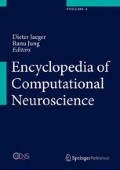Access this chapter
Tax calculation will be finalised at checkout
Purchases are for personal use only
References
Boyd S, Chua LO (1985) Fading memory and the problem of approximating nonlinear operators with Volterra series. IEEE Trans Circuits Syst 32:1150–1161
Buesing L, Schrauwen B, Legenstein R (2010) Connectivity, dynamics, and memory in reservoir computing with binary and analog neurons. Neural Comput 22(5):1272–1311
Buonomano DV, Maass W (2009) State-dependent computations: spatiotemporal processing in cortical networks. Nat Rev Neurosci 10(2):113–125
Buonomano DV, Merzenich MM (1995) Temporal information transformed into a spatial code by a neural network with realistic properties. Science 267:1028–1030
Destexhe A, Contreras D (2006) Neuronal computations with stochastic network states. Science 314:85–90
Dominey PF (1995) Complex sensory-motor sequence learning based on recurrent state representation and reinforcement learning. Biol Cybern 73(3):265–274
Hoerzer GM, Legenstein R, Maass W (2012) Emergence of complex computational structures from chaotic neural networks through reward-modulated Hebbian learning. Cereb Cortex 24(3):677–690
Jaeger H (2001) The “echo state” approach to analysing and training recurrent neural networks – with an erratum note. GMD Report 148: German National Research Center for Information Technology
Lukoševičius M, Jaeger H (2009) Survey: reservoir computing approaches to recurrent neural network training. Comput Sci Rev 3(3):127–149
Lukoševičius M, Jaeger H, Schrauwen B (2012) Reservoir computing trends. KI – Künstliche Intelligenz, pp 1–7
Maass W, Natschlaeger T, Markram H (2002) Real-time computing without stable states: a new framework for neural computation based on perturbations. Neural Comput 14(11):2531–2560
Maass W, Prashant J, Sontag ED (2007) Computational aspects of feedback in neural circuits. PLoS Comput Biol 3(1):e165
Nikolic D, Haeusler S, Singer W, Maass W (2009) Distributed fading memory for stimulus properties in the primary visual cortex. PLoS Biol 7(12):1–19
Rigotti M, Barak O, Warden MR, Wang X-J, Daw ND, Miller EK, Fusi S (2013) The importance of mixed selectivity in complex cognitive tasks. Nature 497:585–590
Further Reading
Webpages
Reservoir Computing. http://reservoir-computing.org
Scholarpedia
Echo State Networks
Author information
Authors and Affiliations
Corresponding author
Editor information
Editors and Affiliations
Rights and permissions
Copyright information
© 2015 Springer Science+Business Media New York
About this entry
Cite this entry
Legenstein, R. (2015). Recurrent Network Models, Reservoir Computing. In: Jaeger, D., Jung, R. (eds) Encyclopedia of Computational Neuroscience. Springer, New York, NY. https://doi.org/10.1007/978-1-4614-6675-8_796
Download citation
DOI: https://doi.org/10.1007/978-1-4614-6675-8_796
Published:
Publisher Name: Springer, New York, NY
Print ISBN: 978-1-4614-6674-1
Online ISBN: 978-1-4614-6675-8
eBook Packages: Biomedical and Life SciencesReference Module Biomedical and Life Sciences

